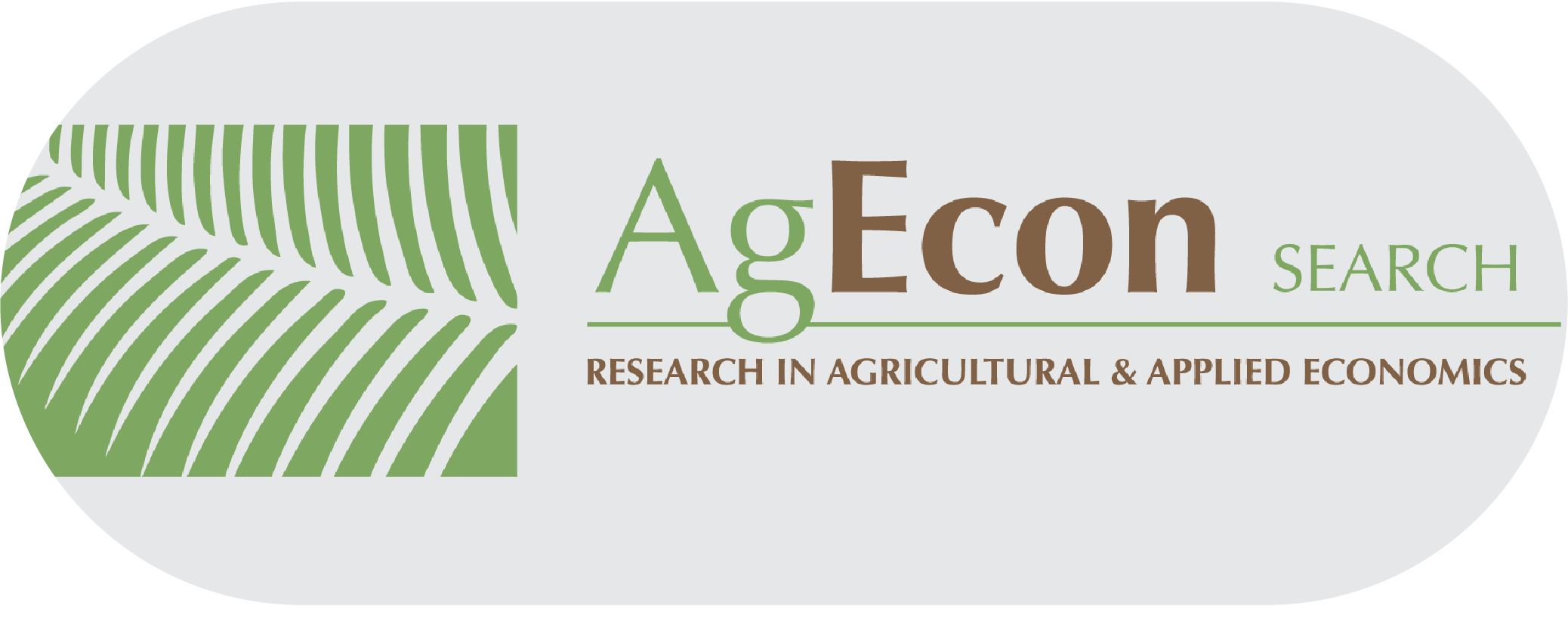Vol. 18 No. 1 (2024): APSTRACT
Full Issue
##issue.tableOfContents##
Articles
-
DECENT WORK AND COFFEE SECTOR: ARE THE COFFEE ESTATES IN KENYA COMPLYING WITH DECENT WORK IN PRODUCTION AND PRIMARY PROCESSING?
Views:256Coffee plays a big role in Kenya, it contributes to 30 percent of agricultural jobs and country’s exports. However, casual workers within coffee estates still get challenging employment conditions including long working hours, unfair wages, limited social capacity, and lack of collective bargaining that results in poor living standards and job insecurity. And also, no research shows compliance with decent work in the Kenyan coffee sector. This study sought to provide new literature about decent work compliance in production and primary processing within Coffee estates in Kiambu county. Snowballing sampling method was used to collect data among 385 casual workers from EAAGADS, Fairview, Maakiou, and Magumu coffee estates. Descriptive statistics and inductive logic were used to generate decent work indices from statistical indicators explaining each decent work pillar. Decent work indices 0.41 and 0.44 show the low compliance of social dialogue and safety at workplace dimensions respectively. Results, also show that effort has been done under productive employment and social protection dimension as shown by indices of 0.65 and 0.51 respectively. Moreover, there is a need for ILO inspection to ensure whether there is a promotion of decent work practices within coffee production to promote the living standards of coffee casual workers and also the stimulation of sustainable development of the County as well as the Country.
PDF166 -
A POTENTIAL USE OF A LANDSCAPE INTEGRATED MANAGEMENT TOOL TO MEASURE THE PROGRESS TOWARDS SUSTAINABILITY: A TRIAL APPLICATION AT THE GRAPE-PRODUCING COMPANY HÉTSZŐLŐ –TOKAJ REGION – DEBRECEN - HUNGARY
Views:258Sustainable integrated management at the landscape scale is increasingly becoming paramount for the private, and public sectors, as these sectors recognize the high relevance of promoting integrated and collaborative management in their operating areas and territories. There has been no attempt to apply this approach in the current sustainability reporting frameworks. this paper aims to run a trustful assessment at the Hétszölö viticulture company to make sustainability claims. This paper applies a new way of reporting sustainability by selecting and assessing suitable indicators within the Ecosystem, Human well-being, and Production pillars depending on the landscape context and conditions, followed by a performance metric selection, prioritization process, and sustainability claiming. Our results portray that out of 21 indicators including core and landscape-dependent indicators in total 9 were determined as applicable, likewise, concerning metrics selection, 5 performance metrics were defined as required, 2 were recommended and 1 was optional. The company´s top prioritized indicators are ecosystem restoration (1.06 % of restored areas nationwide), household income (0.3 % nationwide = < $2.5/day), and health and nutrition (<2.5 % = 42500 children).it is ultimately given some claims that actions must be taken in these prioritized metrics and make positive progress toward sustainability.
PDF92 -
IMPACT OF INFORMATION SYSTEMS IN THE SUPPLY CHAIN: A SYSTEMATIC LITERATURE REVIEW
Views:249Information system (IS) has in many ways impacted supply chain management (SCM), from accumulating. organizing, and assessing data to optimizing the whole operation. With the help of technological advancement and efficient data control, companies can move forward with amending the SCM according to what customers expect. The present study has predominantly focused on how the IS helps the managers and the entire workforce to give their best effort to make SCM successful which accordingly can control the productivity, revenue and data throughout business operations. This systematic literature review is based on an analysis of over 250 articles published in peer-reviewed journals over the last four years to reach out to the learning areas aligned with the topic of how IS aids SCM in different sectors. In general, the findings point out that the integration of information technology into their supply chains provides a competitive advantage. In addition, the study indicates that technology enhances supply chain management's information accessibility, insight, agility, cooperation, and client loyalty. On the other hand, software’s could improve supply chain efficiency, but using new technology comes with risk. Unwilling partners and suppliers, poor planning and preparation, communication difficulties, customer issues, complaints, and awkward encounters are among the common complications.
PDF126 -
SOCIOECONOMIC DETERMINANTS OF THE INTENSITY OF MUSHROOM COMMERCIALISATION IN GREATER ACCRA REGION, GHANA
Views:347Fungi, such as mushrooms, have the unique ability to decompose and convert obstinate organic substances into protein, thereby improving nutrition, increasing food security, fostering sustainable agricultural production, and generating income for farmers. Since the 1990s, the Ghanaian government, through the Mushroom Unit of the Food Research Institute of Ghana, has promoted the cultivation and commercialization of (oyster) mushrooms in Ghana as an additional source of income for the urban poor. This study used a cross-sectional survey design, questionnaires, and validated structured interview schedule instruments to collect data from 153 mushroom farmers in the Ga East and Adentan Municipalities of the Greater Accra Region to determine the intensity, degree, characterisation, and factors that influence the intensity of oyster mushroom. The Crop Commercialization Index, frequency, mean, standard deviation, Two Stage Least Square regression and Ordinary Least Square regression were used to analyze the data. The results showed a low intensity (GHC 10202.20) but a high degree (75%)of oyster mushroom commercialization in the study area. The vast majority of oyster mushroom farmers (95%) were highly commercialized, selling more than half of their oyster mushroom output. Except for age, farmers' level of formal education, land ownership, and production volume of oyster mushroom all positively influenced the intensity of oyster mushroom commercialization. The Food Research Institute, the Ministry of Food and Agriculture, and development organizations should step up efforts to increase oyster mushroom production and attract educated, young, and unemployed people to oyster mushroom ventures.
PDF125 -
THE INVISIBLE HANDS IN THE PRODUCTION OF GHANA’S PREMIUM COCOA: WOMEN AS KEY CONTRIBUTORS
Views:229So often, what women do especially in relation to productive work is ignored by various researchers. This study tries to bring to the limelight the extent to which women are contributing to the production of Ghana’s premium cocoa which is an envy all over the world. A cross-sectional data from 400 women cocoa farmers in Mampong and Tepa Cocoa Districts in the Ashanti Region of Ghana was taken. Data were collected through the use of structured questionnaires. Descriptive and inferential statistics such as percentages, mean, standard deviations, frequencies, multiple linear regression were used for the data analysis. Findings from the study showed that women cocoa farmers play enormous role in the production of cocoa. They play roles in both the pre-harvest stage, and in the post-harvest stage. The results show that women in partnership with their spouses play more active role in cocoa production than women who are sole owners. Marital status, farming experience and educational level are the key factors influencing women farmers production roles. Again, marital status, pre-planting and harvesting activities influence women farmers’ access to resources, privilege, power, and control. Women farmers in partnership with their spouses face the challenge of support from their husbands while women operating as sole owners face the challenge of high cost of labour. Results prove that women cocoa farmers must be massively supported by key stakeholders in the cocoa value chain in order to make them count.
PDF112 -
CONSUMERS’ PERCEPTION AND WILLINGNESS TO PAY FOR ORGANIC TOMATOES IN OFORIKROM MUNICIPAL, ASHANTI, GHANA
Views:198Although conventional tomatoes are often preferred by consumers, organic tomatoes are thought to be safer and healthier. This is because some customers do not fully comprehend the advantages of organic tomatoes. The purpose of this study was to investigate how customers perceive and are willing to pay for organic tomatoes. 399 systematically chosen respondents provided the data, which was collected. The data were analyzed using descriptive and inferential statistics such the Perception Index, Contingent Valuation Method, and Tobit Regression Model. The findings indicated that the majority of respondents were familiar with organic tomatoes. A perception rating of 1.24 indicates that respondents had a favorable opinion of organic tomatoes. Organic tomato buyers were willing to spend at least GHC 9.63 per kilo. Consumers' willingness to pay for organic tomatoes was influenced by their view of the health benefits, their level of education, their income, and their knowledge of and familiarity with organic tomatoes. As a result, the study advises producers or farmers to inform their customers about the health advantages of organic tomatoes and to focus on consumers with high incomes and educational levels since these factors greatly influenced their willingness to pay.
PDF102 -
QUANTITATIVE RESEARCH OF FACTORS (CONVENIENCE OF ACCESS AND GENDER) INFLUENCING THE FOOD STORE CHOICE IN NAGYKŐRÖS
Views:190The objective of the research is to analyze the food purchasing decisions of Hungarian customers depending on priority factors (convenience of access and gender) that impact the food store choice.
To identify the characteristics of food shopping behaviour, we conducted a customer survey of 220 individuals in the city of Nagykőrös. The data collection was carried out using a standard questionnaire and an online survey on the Nagykőrös public life community social media portal, and by informing shoppers about the possibility to fill in the questionnaire in the Municipality’s posts. The sample can be considered representative based on the gender distribution of the primary food purchaser.
During the analysis of the data, in addition to descriptive statistics, we utilized factor analysis to describe the mindset of the customers, and created segments based on the factors influencing the choice of store using cluster analysis.
For the vast majority of consumers, the primary determinant in selecting a store is the affordable price level, regardless of how often they make purchases. When shopping on a daily basis, customers prioritize the store’s proximity to their residence, promotional discounts, and variety of products available. Men tend to value a relaxed ambiance and convenient parking, while women prioritize special deals and competitive prices when choosing their regular shopping location
We have identified price sensitivity, accessibility, location, and atmosphere as key factors. Throughout our research, we have categorized customers into four distinct clusters: Action-oriented family members (36.1%), Conscious shopping family members (29.9%), Price-conscious seniors (20.6%), and Curious beginners (13.4%).
A significant hurdle for Hungarian retail companies is to enhance the quantity of their loyal customers, which they can solely achieve by taking market share from their rivals (primarily other retail companies). Initially, they must determine whether their customer base favours their kind of store for everyday or bulk shopping. They must cater to the demands of their target customer base (potentially the clusters established by our research) in relation to the key factors influencing store selection and purchase frequency, in order to attain success in their business. We suggest utilizing the factors that influence store selection as segmentation criteria.
PDF122 -
PHARMA SUPPLY CHAIN RESILIENCE. A SYSTEMATIC REVIEW
Views:351This study offers a thorough exploration of critical consideration of resilience in pharmaceutical supply chains, aiming to provide a comprehensive overview of the existing literature on this subject. Given the increasing globalization, regulatory complexities, and disruptions, the pharmaceutical industry encounters unique challenges in maintaining the business continuity of supply chains. Design/Methodology/Approach: We conducted a systematic analysis of 41 documents, including articles, reviews, and conference papers, employing bibliometric methods to visualize the dataset. Findings: Our findings indicate a notable increase in literature in recent years, particularly concerning risk mitigation strategies, collaboration among supply chain stakeholders, and investments in technology-driven solutions for resilience in pharmaceutical supply chains. Furthermore, we have identified several research directions. This review emphasizes the necessity for ongoing scholarly efforts aimed at fostering pharmaceutical supply chains resilience given the post-COVID-19 situation with goal of ensuring the uninterrupted availability of essential medications to patients worldwide.
PDF261 -
DO MULTIPURPOSE COOPERATIVES HAVE ADDRESSED THEIR MEMBER’S AGRICULTURAL OUTPUT MARKETING CHALLENGES OF SMALL HOLDER FARMERS IN ETHIOPIA?
Views:246Multipurpose cooperatives offer a powerful tool for enhancing the livelihoods of small-scale farmers, particularly in developing economies. By joining forces, these farmers gain greater collective bargaining power, allowing them to negotiate better prices for their crops and increase their incomes. In developed countries as well, farmer cooperatives play a central role in streamlining production and marketing activities for family farms. They act as a crucial bridge between farmers and markets, ensuring smoother exchange and coordination within the agricultural sector. However, despite their significant contributions, multipurpose cooperatives also face challenges that influence them to play a significant role of agricultural product marketing. The aim of this study was to examine the benefits and difficulties associated with members of a multipurpose cooperative participating in the sale of agricultural products in the Kersa district of Jimma Zone, Oromia Regional State, Ethiopia. For this study, four multipurpose cooperatives were chosen using a two-stage sampling technique, resulting in a sample size of 196 cooperative members. Quantitative data was collected through a structured questionnaire from primary sources, while qualitative data was collected through focus groups and key informant interviews. Descriptive statistics such as mean, chi-square, standard deviation, frequency, and percentage were used to analyze the data. The result showed that 66.36% of cooperative members were participants, whereas 33.64% were non-participants. Multipurpose cooperatives are serving as the primary source of agricultural inputs. However, the output marketing activity of the sampled multipurpose co-operatives in the district is not as remarkable. The study suggests that local cooperative agencies should encourage more members to participate in selling their crops through the cooperatives
PDF138






